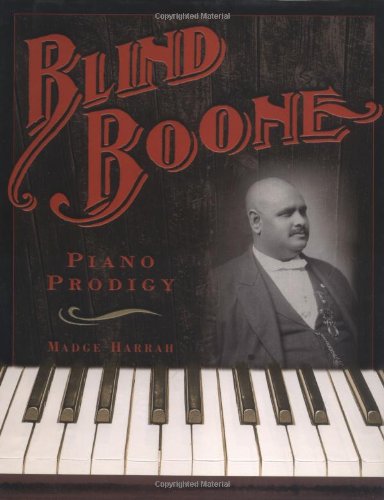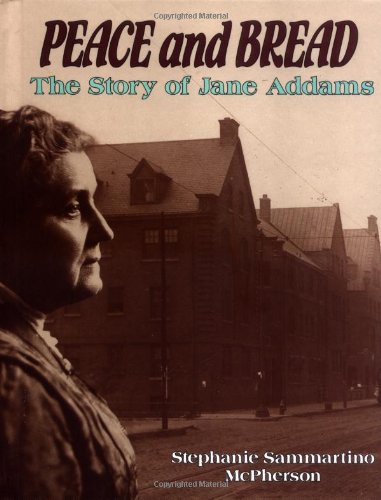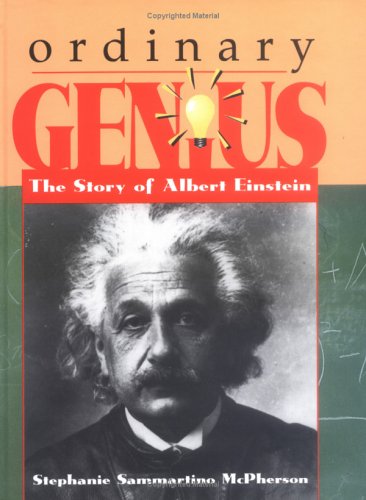-
Blind Boone: Piano Prodigy
Madge Harrah
Library Binding (Lerner Pub Group, Aug. 1, 2003)Presents the life and career of the blind pianist who toured the country after the Civil War, bringing ragtime and other African American music to the concert stage. V
V
-
Ordinary Genius: The Story of Albert Einstein
Stephanie Sammartino McPherson
Paperback (First Avenue Editions ™, Jan. 1, 1995)What do you think of when you hear the name Albert Einstein? Perhaps you picture an old man with rumpled clothing, a halo of wild white hair, and an impish grin. You might know that he developed two of the most important and complex theories in science, the theories of relativity. You probably think of the word genius. Albert Einstein may have been a genius--but he was also much more than that. Einstein was a man who hated violence and took a stand for peace in the world. He was a man who was proud to be Jewish and worked to ensure a better life for his people. And he was a man who never took himself--or his fame--too seriously, and only wanted to be treated like an ordinary person and live an ordinary life. U
U
-
Victoria Woodhull: Fearless Feminist
Kate Havelin
Hardcover (Twenty-First Century Books, June 27, 2006)Chronicles the life of the first woman to run for United States president, who was also one of the first women in the United States to run a stock trading business and publish a weekly newspaper. Z
Z
-
Maggie L. Walker: Pioneering Banker and Community Leader
Candice F. Ransom
Library Binding (Twenty-First Century Books, Nov. 1, 2008)Retells the life and career of Maggie L. Walker, who founded the St. Luke Penny Savings Bank, the first bank established specifically for African Americans. T
T
-
Native American Doctor: The Story of Susan Laflesche Picotte
Jeri Ferris
Paperback (First Avenue Editions, Nov. 1, 1991)A biography of the young Omaha Indian woman who became the first Native American woman to graduate from medical school. V
V
-
Arctic Explorer: The Story of Matthew Henson
Jeri Ferris
Paperback (First Avenue Editions TM, Aug. 1, 1989)Through howling snowstorms and over treacherous sheets of ice, Matthew Henson and Robert Peary raced against other explorers and death itself to be the first to reach the North Pole. After six expeditions and eighteen years, they finally planted the American flag at the top of the world on April 6, 1909. Because he was a black man, Henson had to start out as Peary's servant. But with his intelligence, bravery, and resourcefulness, Matthew Henson soon became Peary's chief assistant. P
P
-
Peace and Bread: The Story of Jane Adams
Stephanie Sammartino McPherson
Library Binding (Carolrhoda Books, Sept. 1, 1993)Discusses the accomplishments of Jane Addams, a pioneering social worker who created Hull House, a community center and social service organization built in Chicago in the late 1800s, and her work with immigrants of many different nationalities. W
W
-
Ordinary Genius: The Story of Albert Einstein
Stephanie Sammartino McPherson
Library Binding (Carolrhoda Books, March 1, 1995)A chronicle of the life of the great scientist Albert Einstein features a simple yet informative text that focuses not only on his scientific discoveries but on his personal life, including his Jewish pride and his hatred of violence. V
V
-
Native American Doctor: The Story of Susan Laflesche Picotte
Jeri Ferris
Library Binding (Carolrhoda Books, Dec. 1, 1991)A biography of the young Omaha Indian woman who became the first Native American woman to graduate from medical school. V
V
-
Jump at de Sun: The Story of Zora Neale Hurston
Anthony Porter
Paperback (First Avenue Editions TM, Aug. 1, 1992)In the all-black town of Eatonville, Florida, Zora Neale Hurston's mother used to tell her to "jump at de sun." She wanted Zora to be proud of herself and to do great things. Zora took her mother's words to heart. But when Zora was thirteen, her mother died. From then on, Zora wandered from job to job and school to school, always just squeaking by. Eventually, as a contributor to the Harlem Renaissance and as an anthropologist, Zora began writing and collecting the kinds of African-American tales she had heard as a child in Eatonville. Zora sparked a revolution in American thought. Her works urged African Americans to be proud of their background and to stop trying to be white. Zora's stories, plays, and folktale collections have won ongoing acclaim because of their power, vitality, and beauty. In Jump at de Sun, A.P. Porter takes readers on the lonely and exciting road that brought Zora from Eatonville to a place in history. M
M
-
Forgotten Voyager: The Story of Amerigo Vespucci
Ann Fitzpatrick Alper
Library Binding (Carolrhoda Books, June 1, 1991)A biography of Amerigo Vespucci, whose discoveries of the American continent remained unrecognized for many centuries V
V
-
Mary Cassatt: Portrait of an American Impressionist
Thomas Streissguth
Library Binding (Twenty-First Century Books, Nov. 1, 1998)Presents the life and work of Mary Cassatt, the only American artist included with the French Impressionists. W
W